The Week That Was
While the new year is still very young and a lot can happen before it's over, one widely held fear—that sharp profit-taking would hit markets at the outset of 2018—has not taken place...at least not yet. Rather, investors keep driving toward fresh record highs in as-yet-uncharted market territory.
Indeed, all four major US indices registered new records last week, and in most cases—save for the Russell 2000 which continued to be the laggard with just a single record—some indices made three or four new highs.
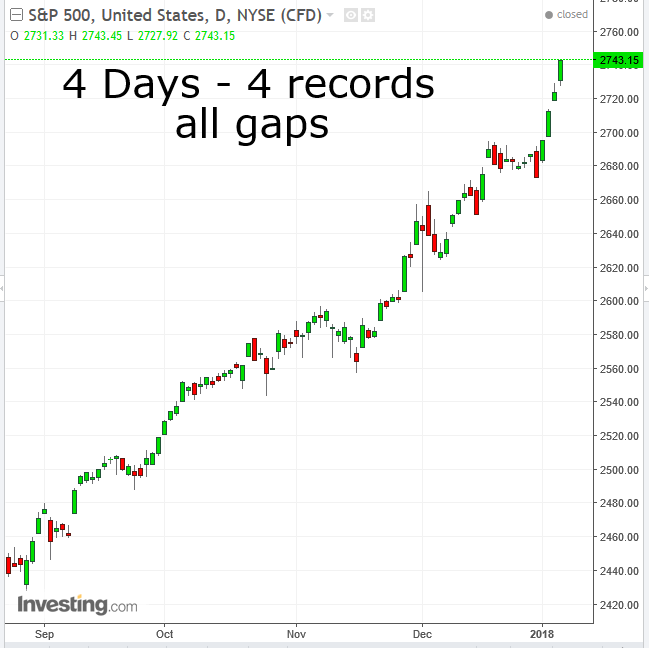
The S&P 500 jumped 2.6 percent. It recorded its best weekly performance during the first week of 2018, besting its full-year 2017 performance for that metric.
The Dow Jones Industrial Average powered past the 25,000 level for the first time, then just kept going higher. The first record breaker was followed by a second consecutive rising gap and a Friday close practically at the height of the session, a clear statement that bulls would give bears no quarter.
Internally, the S&P 500's Materials sector led, gaining 3.85 percent, followed closely by Technology, up 3.67 percent. Utilities had the biggest sector losses, down 2.56 percent, followed by Real Esate which was off by 2.03 percent, the only two sectors in the red.
US economic growth remains on pace from 2017 figures, still growing but below expectations. The US labor force added 148,000 jobs in December. That falls short of the 190,000 expected, but the three-month average still exceeds the 200,000 key level. The unemployment rate of 4.1 percent remains at a 17-year low, capped by two consecutive GDP quarters above 3 percent.
International markets followed the US rallies higher, much as they did in 2017. It’s noteworthy for investors to understand the causal relationship between the various economies and markets.
An economic upside surprise in China would boost European and American stocks; a better-than-expected economic release in the US or a stock rally would buoy European and Chinese stocks. However, European economic strength or a eurozone equity market rally would rarely lead the other economies. Rather, it would only benefit investors focused on Europe.
The annual growth rate for the global economy, such as China, the EU and the US bottomed during mid-2017. China’s growth rate is the strongest globally with near 7 percent expansion, followed the US, up 3+ percent. Europe’s growth comes in behind in the mid-2 percent levels.
However, a deeper drill-down comparing respective national economic growth may leave an economist puzzled. While China’s growth was the strongest, its MoM progression was the weakest, by a tenth of a percent. As well, while in the last two quarters the rate of growth for the US was more than half a percent stronger than that of the EU, it followed two weak quarters. In the final analysis, Europe’s economic MoM growth was the strongest and most consistent. Why, then has it been a laggard?
Asia – China
The MSCI AC Asia Pacific tracks large and mid-cap stocks across five developed markets and nine emerging markets including China, South Korea, Japan, Australia and Taiwan. It rallied 30 percent over the course of 2017. The best performing major market for the year was Hong Kong’s Hang Seng, which rose more than 35 percent.
US
The three major US indexes were strong in 2017 as well. The S&P 500 Index advanced 19.4 percent for the year; the Dow Jones Industrial Average climbed 25.20 percent and the NASDAQ Composite closed the year even higher, up 28.35 percent.
Europe
But here's the real surprise. Despite Europe’s more consistent and larger incremental growth, its markets have underperformed Asia and the US.
The Stoxx 600 Index climbed 7.7 percent. The Stoxx 50 advanced 8.4 percent. Germany's DAX gained 12.5 percent while France's CAC 40 added 9.3 percent. The UK's FTSE 100 rallied just 7.6 percent.
Why would consistently stronger European growth not be translated into regional markets that outperform? We've previously and repeatedly discussed the fact that Europe was usurping the mantle of global economic leadership from both China and the US. Our first mention of the subject occurred on May 30.
Surprisingly—or not—we may have answered the question in that first analysis:
“Which region is the better bet from an economic growth standpoint? Recent European data beat American and Chinese data, yet the European central bank appears to be continuing its expansive monetary policy, while both American and European markets are fraught with political risk.”
The ECB is the only central bank among those in this comparison that did not raise rates. Meanwhile, the IHS Markit’s Final Composite Purchasing Manager’s Index, an overall growth indicator for the region, advanced to its highest level since February 2011. This is likely to force the ECB to finally close out its aggressive stimulus.
That, however, won’t help European investors in 2017. It may help investors in 2018 though. Will this be the year then that eurozone monetary policy and its equity markets catch up?
Another challenge European investors faced in 2017 was the growing strength of the euro, which gave US companies an 'unfair' advantage. It was the single currency's best year since 2003; it gained 14 percent.
At the same time, it was the dollar’s worst year over the same period. The greenback fell nearly 10 percent.
A strong currency makes a country’s exports more expensive for importing countries, thereby hurting sales growth. In addition, why should international investors buy European stocks if they have a less favorable exchange rate to the dollar? They might as well buy US stocks, especially considering that US exports stand to rise on a weaker and thus cheaper currency.
Despite Fears, 2018 Starts Stronger Than 2017
Despite dire predictions, the new year started stronger than where its predecessor left off. Investors are clearly not paying any attention to the numerical changes on their calendars.
As long as the economy continues to grow, and company profits expand, investors are clearly signaling they're willing to stay on this train. In all likelihood, investors spurned European stocks not because of eurozone fundamentals, which were fine; corporate earnings outperformed that of the US. Investors may simply have scorned European equities because of its central bank's monetary policy and a strong single currency.
International Stock-Market Outlook
The Markit Final Composite PMI for the eurozone indicated growth for the region was at a 7-year high. This is likely to force the ECB into tightening. That could erase one trigger for lagging European stocks. The second, a strong currency, may also get a reprieve after the event; a euro correction is probably overdue and would be prompted by the change in policy. Should this occur it would potentially provide EU stocks a lead in the coming year.
Dollar Index
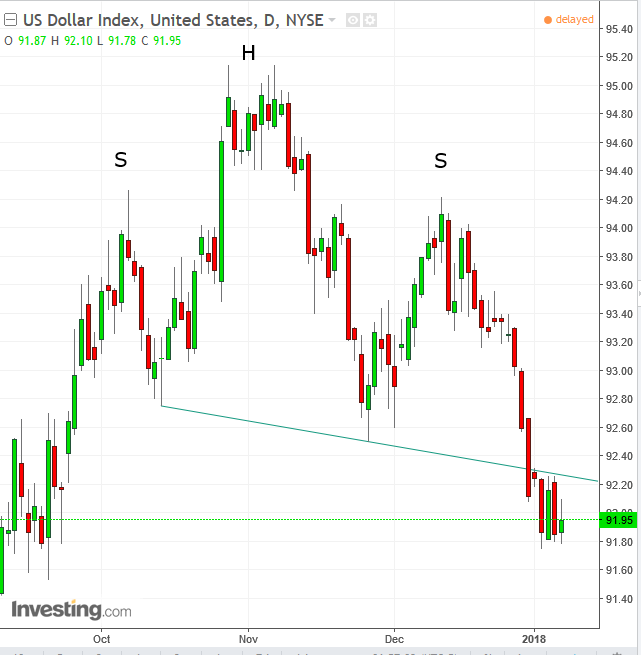
Persistently low inflation, compounded by a flat yield, finalized by Fed officials’ inflation concerns led investors to sell the dollar. It fell less than 0.2 percent, extending its decline into a third week, though the drop was just a fraction of the currency's slide during the previous week. It completed a H&S top, but its neckline penetration was only 0.65 percent, falling short of even the aggressive, minimum filter of 1.00 percent.
Euro
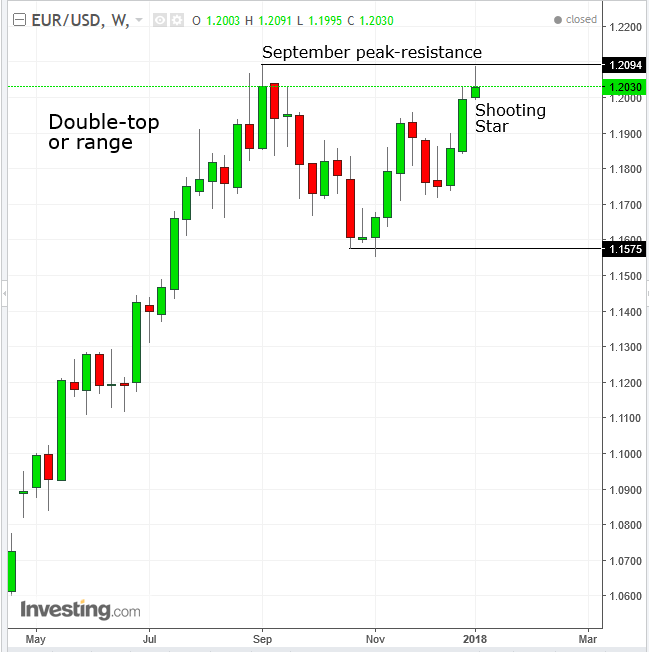
In a mirror image of the USD, the euro advanced 0.28 percent, but was ultimately pushed down, forming a bearish shooting star. The bearish significance of the candlestick is its price level, the September, 1.2100 peak, suggesting considerable supply is waiting to form a resistance.
Gold
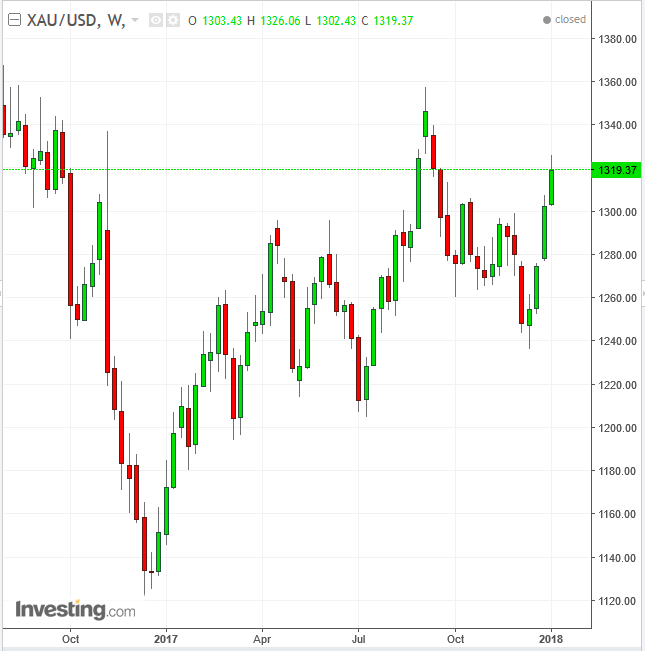
Gold, which often acts contrary to the dollar, extended a fourth straight week of gains, + 1.25 percent, which was greater than the dollar's decline. This may suggest that market players might be buying gold contracts as a hedge against the exuberance of stocks.
Bitcoin: Populist Asset for a Populist Era?
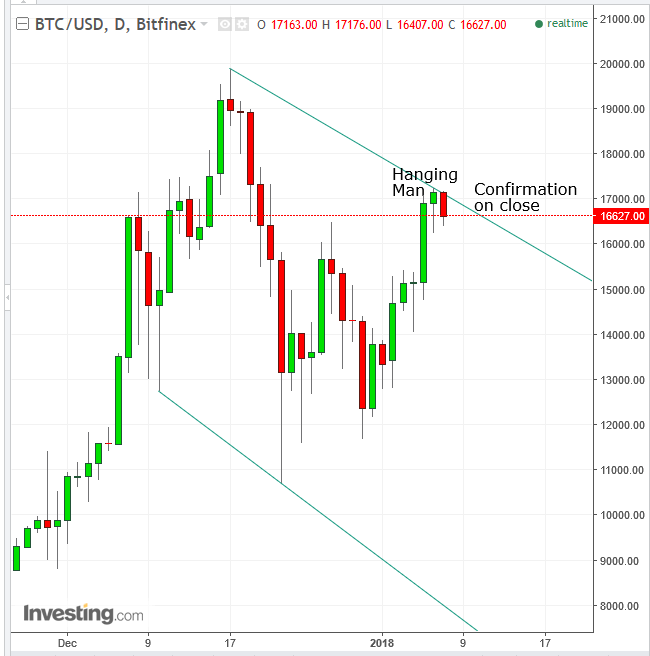
One of the hallmarks of 2016 was the growth of populism: from the surprising result of the Brexit vote to the election of Donald Trump. Perhaps that sentiment extended into 2017 via the growth of Bitcoin which has been taken up as the asset of the people, if not (yet) of institutions. After gaining 1,400 percent in 2017, it can no longer be ignored by financial institutions, as has been proven true by the start of futures trading on the cryptocurrency in December on both the CME and CBOE exchanges.
We suspect the timing of its meteoric rise is due, arguably to the global crackdown on binary options and in some locations on forex trading. The original crackdown on forex spawned binary options. As a new market, it was not regulated. Now that regulators have caught up, brokers—always one step ahead—may have just found a new unregulated market in cryptocurrencies from which to profit. However, global regulators may already be on the case.
Oil

The combination of a pipeline explosion in Libya—one of only two OPEC members with no production quotas—which interrupted supply, alongside growing global demand and falling US production, capped by a softer dollar, pushed the price of oil over the $60 key level to a three year high.
However, while the price of WTI climbed 1.7 percent to close the week at $61.44, the gains occurred on Wednesday while Thursday’s advance produced a high-wave candle, followed by a Bearish Engulfing pattern, suggesting a correction is on the horizon.
The Week Ahead
All times listed are EST
Monday
5:00: Eurozone – Business Confidence (December): expected to rise to 1.55 from 1.5.
Tuesday
2:00: Germany – Trade Balance (November): surplus expected to rise to €20.1 billion from €18.9 billion.
5:00: Eurozone – Unemployment (November): rate expected to rise to 8.9% from 8.8%.
20:30: China – CPI (December): expected to rise to 1.8% YoY and 0.1% MoM, from 1.7% and 0% respectively.
Wednesday
4:40: UK – Trade Balance (November): deficit forecast to widen to £3.3 billion from £1.4 billion.
Thursday
7:30: Eurozone – ECB Minutes: this will provide further insight into the economic conditions influencing eurozone monetary policy.
8:30: US – PPI (December): factory-gate inflation forecast to be 0.3% MoM from 0.4%.
23:45: China – Trade Balance (December): forecast to see a surplus of $35 billion, down from $40 billion in November.
Friday
8:30: US – CPI, Retail Sales (December): CPI forecast to be 2.2% YoY and 0.2% MoM, from 2.2% and 0.4% respectively. Core CPI forecast to be 1.8% YoY from 1.7%. Retail sales forecast to grow 0.4% from 0.8% MoM.
